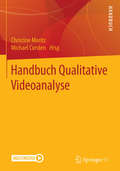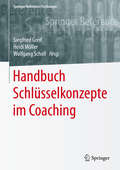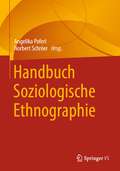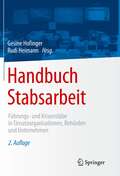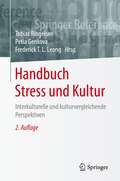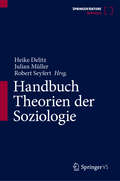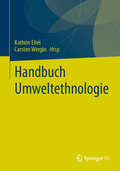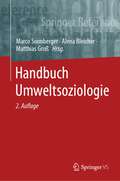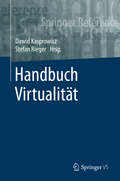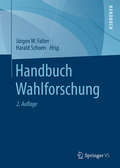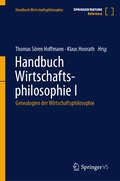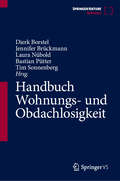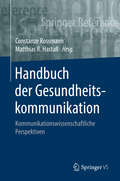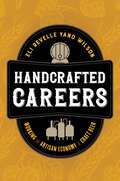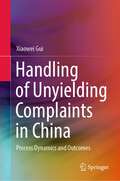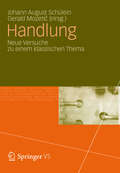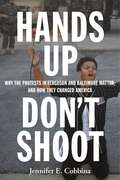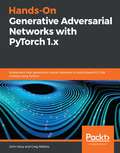- Table View
- List View
Handbuch Qualitative Videoanalyse
by Christine Moritz Michael CorstenDas Handbuch bietet einen breiten und vollständigen Überblick über die derzeit wichtigsten qualitativen Methoden der Videoanalyse und Filmanalyse sowie deren Entwicklungen in den Sozialwissenschaften und schließt somit in einem Fachbereich, der durch hohe Diversität gekennzeichnet ist, eine noch immer bestehende Lücke. Zudem geht der Band forschungspraktisch auf die bestehenden methodischen und methodologischen Herausforderungen ein, differenziert und arbeitet auf diese Weise die bestehenden Anforderungen im Umgang mit dem besonderen Datentypus nachvollziehbar heraus.Videos per App: Laden Sie die Springer Multimedia App kostenlos herunter - Abbildungen im Buch per App mit Handy oder Tablet scannen, um Videos zu streamen.
Handbuch Schlüsselkonzepte im Coaching
by Heidi Möller Wolfgang Scholl Siegfried GreifDieses Handbuch widmet sich den wissenschaftlichen Grundlagen des Coachings und zeigt deren Anwendungsmöglichkeiten anhand praktischer Beispiele auf. Damit liefert es insbesondere Coaches und Coachingausbildungen fundiertes Fachwissen als Fundament für ihre Profession. Wissenschaftler/innen finden einen aktuellen Überblick über den Stand der Forschung. Mit 70 Beiträgen ausgewiesener Fachexperten/innen verschiedener Länder und Disziplinen zu grundlegenden Schlüsselkonzepten im Coaching ist dieses Handbuch ein einzigartiges Referenzwerk. Die Beiträge beschreiben die praktische Anwendung des Wissens und beginnen dazu in der Regel mit einem Fallbeispiel aus dem Coaching.
Handbuch Soziale Praktiken und Digitale Alltagswelten (Springer Reference Sozialwissenschaften Ser.)
by Heidrun Friese Marcus Nolden Gala Rebane Miriam SchreiterMit der Entwicklung des Web 2.0. sind digitale Medien und Netzwerke zum Teil unseres Alltags geworden. Von Facebook und Twitter zu YouTube und Blogspot: Soziale, kulturelle, religiöse, ökonomische und politische Räume entwickeln sich mittlerweile auch im weltumspannenden Netz, erlauben die Verständigung über die gegenwärtige Situation und lassen die einstige Unterscheidung zwischen ‚online und offline-Welten‘, dem ‚virtuellen‘ und dem ‚realen, physischen‘ Raum obsolet werden. Diese digitalen Räume werden inzwischen nicht mehr als abgegrenzt betrachtet, sondern vielmehr als Kontinuum sozialer Felder verstanden, die von unterschiedlichen Praktiken und transnationaler Kommunikation gekennzeichnet sind.
Handbuch Sozialwissenschaftliche Gedächtnisforschung: Band 1: A–L
by Gerd Sebald Oliver Dimbath Michael Heinlein Hanna Haag Nina Leonhard Mathias Berek Kristina Chmelar Valentin RauerDer Begriff ›soziale Gedächtnisse‹ eröffnet neue Perspektiven für die Beschreibung komplexer sozialer Phänomene in gegenwärtigen gesellschaftlichen Zusammenhängen, indem er die Vielschichtigkeit der Vergangenheitsbezüge in hochgradig differenzierten modernen Gesellschaften aufzeigt und fassbar macht. Das vorliegende Handbuch erschließt Grundbegriffe, Theorien, Problemfelder sowie Praktiken und Objekte von Vergangenheitsbezügen unter dem Aspekt sozialer Gedächtnisse. Damit zeichnet es sich durch eine explizit auf sozialwissenschaftliche Theorien und Ansätze ausgerichtete Konzeption aus, erreicht eine größere ›Tiefe‹ terminologisch-konzeptueller Probleme und systematisiert das inter- und transdisziplinäre Forschungsfeld.
Handbuch Sozialwissenschaftliche Gedächtnisforschung: Band 2: M–Z
by Gerd Sebald Oliver Dimbath Michael Heinlein Hanna Haag Nina Leonhard Mathias Berek Kristina Chmelar Valentin RauerDer Begriff ›soziale Gedächtnisse‹ eröffnet neue Perspektiven für die Beschreibung komplexer sozialer Phänomene in gegenwärtigen gesellschaftlichen Zusammenhängen, indem er die Vielschichtigkeit der Vergangenheitsbezüge in hochgradig differenzierten modernen Gesellschaften aufzeigt und fassbar macht. Das vorliegende Handbuch erschließt Grundbegriffe, Theorien, Problemfelder sowie Praktiken und Objekte von Vergangenheitsbezügen unter dem Aspekt sozialer Gedächtnisse. Damit zeichnet es sich durch eine explizit auf sozialwissenschaftliche Theorien und Ansätze ausgerichtete Konzeption aus, erreicht eine größere ›Tiefe‹ terminologisch-konzeptueller Probleme und systematisiert das inter- und transdisziplinäre Forschungsfeld.
Handbuch Soziologische Ethnographie
by Angelika Poferl Norbert SchröerEthnographie setzt an der empirischen Erforschung von sozialem Handeln, Lebenswelten, Praktiken, institutionellen Kontexten und kulturellen Orientierungen durch Beobachtung, Ko-Präsenz, längerfristige Teilnahme und Teilhabe an dem zu untersuchenden Feld an. Ihre Ursprünge liegen in der Ethnologie und im Journalismus. Die in den 1910er bis zu den 1930er Jahren durchgeführten Studien der Chicago School haben beide Verfahrensansätze aufgegriffen, um die Dynamik und die zunehmende Unübersichtlichkeit gesellschaftlicher Wirklichkeit beschreiben zu können. Dies hat zur Entstehung einer soziologischen Ethnographie geführt, die ihre Aufmerksamkeit auf soziale und kulturelle Differenzierungen in der je eigenen Gesellschaft richtet.Ziel und Anliegen des Handbuches ist es, einen systematischen Überblick über Ausgangslagen, zentrale Ansätze, Debatten und Ausdifferenzierungen von soziologischer Ethnographie als Forschungsweise zu geben und zugleich die Entfaltung ethnographischer Forschung von ihren historischen Anfängen und Grundlegungen Ende des 19. und Anfang des 20. Jahrhunderts über Weiterentwicklungen in den 1960er Jahren, entscheidende Weichenstellungen in den 1970er und 1980er Jahren bis hin zu ihrer gegenwärtigen Vielgestaltigkeit nachzuzeichnen.
Handbuch Stabsarbeit: Führungs- und Krisenstäbe in Einsatzorganisationen, Behörden und Unternehmen
by Gesine Hofinger Rudi HeimannStabsarbeit effizient und effektiv gestalten!Diese erweiterte, komplett überarbeitete Neuauflage des Handbuchs zur Stabsarbeit bietet einen anwenderorientierten Überblick über die Arbeit von Führungs- und Krisenstäben, ihre Voraussetzungen und Erfolgsbedingungen. Basierend auf der Expertise eines interdisziplinären Autorenteams erhalten Sie alle wichtigen Grundlagen, Prozesse und Strategien der Stabsarbeit zur Bewältigung komplexer Schadenslagen oder Einsatzsituationen. Zudem werden Fallbeispiele aus verschiedenen Bereichen vorgestellt.Zum InhaltGrundlagen der Stabsarbeit: Konzepte, Formen, Historie und ethische AspekteStabsarbeit in den Bereichen Militär, Polizei, Feuerwehr, Katastrophenschutz, Störfall- & Prozessindustrie, Verwaltung, Unternehmen, Krankenhaus, Schule und PolitikFühren und Entscheiden im Stab: Planung und Kontrolle, Lagebesprechungen, Beurteilen, Entscheiden und Entscheidungshilfen, Stress und StressbewältigungKommunikation und InformationsflüssePersonalauswahl, Ausbildung und Training von StäbenKonzepte und Gestaltung von StabsräumenSchnittstellen zwischen verschiedenen Stäben und FunktionenFallbeispiele aus der Praxis von KrisenstäbenDie ZielgruppenPersonalleitungen und Führungskräfte, Stabsmitglieder und Entscheider an der Spitze eines Stabes aus behördlichen oder privatwirtschaftlichen Bereichen, Verantwortliche im Katastrophenschutz, Notfall- und Krisenmanagement.Die HerausgeberDr. Gesine Hofinger ist Diplom-Psychologin, Partnerin von Team HF – Human Factors Forschung Beratung Training sowie wissenschaftliche Mitarbeiterin an der Universität Jena. Sie forscht im Bereich Bevölkerungsschutz und publiziert zu Stabsarbeit und Human-Factors-Psychologie. Sie bildet Krisenstäbe aus, ist an der Durchführung und Beobachtung von Stabsübungen aktiv beteiligt und führt After Action Reviews mit Stäben durch. Sie ist Vorsitzende der Plattform „Menschen in komplexen Arbeitswelten“ e. V.Rudi Heimann ist Polizeivizepräsident, zuvor Leiter einer zentralen Ausländerbehörde und in unterschiedlichen Führungsfunktionen in der hessischen Polizei tätig, währenddessen Polizeiführer und Leiter Führungsstab. Lehrtätigkeit in Kriminologie, Führungslehre und polizeiliches Einsatzmanagement an der Fachhochschule der Polizei in Hessen sowie Gastdozent u. a. an der Deutschen Hochschule der Polizei. Kommentierung der bundesweiten PDV 100 VS-NfD- Führung und Einsatz der Polizei. Spezialisiert auf Entscheidungsfindung und Stabsarbeit. Zahlreiche Publikationen mit Themenbezug. Vorstandmitglied der Plattform „Menschen in komplexen Arbeitswelten“ e. V.
Handbuch Stress und Kultur: Interkulturelle und kulturvergleichende Perspektiven
by Frederick T. L. Leong Petia Genkova Tobias RingeisenDas Handbuch fasst den Forschungsstand zum Zusammenhang von Kultur, Stress und Gesundheit zusammen. Das Besondere ist dabei, dass sowohl kulturvergleichende als auch interkulturelle Ansätze berücksichtigt und ihre Wechselwirkungen betont werden. Insgesamt 45 Kapitel greifen aktuelle Fragestellungen aus Theorie und Praxis auf und stellen zugehörige Betrachtungsebenen, Untersuchungsmethoden und Forschungsergebnisse dar. Themen umfassen z.B. (gesundheits)psychologische Implikationen von Migration, Forschungsmethoden für kulturvergleichende und interkulturelle Fragestellungen oder Stress(bewältigung) in multikulturellen Settings. Für die zweite Auflage wurden die Bereiche „Stress und Gesundheit im Kontext Migration und Flucht“ sowie „Stress und Gesundheit in interkulturellen Bildungssettings“ mit insgesamt 13 Beiträgen neu aufgenommen. Die Beträge der anderen vier Bereiche wurden aktualisiert und grundlegend überarbeitet. Ergänzend sind eine Vielzahl neuer Kapitel hinzugekommen. Neue Inhalte umfassen z.B. die gesundheitsbezogenen Folgen von Flucht und Migration, kultursensible Methoden zur Datenerhebung oder Ansätze zum Umgang mit Stress in ausgewählten interkulturellen Settings.
Handbuch Theorien der Soziologie
by Julian Müller Robert Seyfert Heike DelitzDas Handbuch folgt dem Ziel, möglichst diverse soziologische Theorieansätze zu versammeln und die Breite soziologischen Denkens sichtbar zu machen − zugleich geht es um eine Übersicht, eine Ordnung der Theorien. Der Anspruch liegt damit weniger auf enzyklopädischer Vollständigkeit aller Theorien, als auf der Vollständigkeit des Spektrums der soziologischen Denkweisen (ihrer Konzepte, Vokabulare, Methodologien und Forschungsprogramme, ihrer jeweiligen Aversionen gegenüber anderen Ansätzen).
Handbuch Umweltethnologie
by Carsten Wergin Kathrin EitelDas „Handbuch Umweltethnologie“ bildet den Stand der Forschung der Umweltethnologie ab und beleuchtet die komplexen Mensch-Umwelt-Beziehungen. Es untersucht, wie kulturelle und soziale Wechselwirkungen diese Verhältnisse gestalten und verändern und legt besonderes Augenmerk auf die unterschiedlichen Konstruktionen und Verständnisse von Naturen und Kulturen sowie auf die Dynamik zwischen Mensch, Kultur und Umwelt.
Handbuch Umweltsoziologie
by Matthias Groß Marco Sonnberger Alena BleicherDas Handbuch Umweltsoziologie bietet eine umfassende und aktuelle Übersicht über das breite und dynamische soziologische Forschungsfeld zum Natur-Gesellschaftsverhältnis. Es führt in die aktuellen theoretischen und methodischen Ansätze im nationalen und internationalen Kontext sowie zukunftsweisende Forschungs- und Praxisfelder ein. Das Handbuch zeigt darüber hinaus die Herausforderungen und Chancen der umweltsoziologischen Forschung in Kooperation mit anderen Disziplinen auf.
Handbuch Virtualität
by Stefan Rieger Dawid KasprowiczDas Handbuch positioniert den inflationär gebrauchten Begriff „Virtualität“ neu. Er soll nicht länger einen Ausnahmetatbestand unserer Gegenwartskultur bezeichnen. Auch soll er nicht länger auf bestimmte Bereiche (Unterhaltung, Computerspiel) beschränkt bleiben. Vielmehr hat er inzwischen Normalität erlangt und soll in eben dieser Normalität auch beschrieben werden. Dazu werden in Fallstudien sehr unterschiedliche Schauplätze in den Blick genommen, die in der Lebenswelt verankert sind: Diese reichen von der Pädagogik bis zur Medizin, von der Kunst bis zur Industrie, von einer veränderten Kriegsführung bis zu alternativen Konzepten von Autorschaft.
Handbuch Wahlforschung
by Jürgen W. Falter and Harald SchoenDie empirische Wahlforschung zählt zu den theoretisch und methodisch am weitesten entwickelten, von der Öffentlichkeit am stärksten beachteten Zweigen der Politikwissenschaft. Dieser Band vermittelt Grundlagenwissen über die zentralen Konzepte, Methoden und Befunde der empirischen Wahlforschung und gibt einen Überblick über den aktuellen Stand der Forschung. Den Schwerpunkt bilden theoretische Ansätze zur Erklärung von Wahlverhalten. Sie werden ausführlich dargestellt, kritisch diskutiert und systematisch miteinander verglichen. Daneben geht der Band auf ausgewählte Themen der Wahlforschung ein, u.a. auf Nichtwahl, Wechselwahl, die Wahl extremer Parteien sowie den Einfluss von Wertorientierungen und Massenmedien auf das Wahlverhalten. Ferner enthält er Überblicke über die Geschichte demokratischer Wahlen, die Historische Wahlforschung, die Wahlsystemforschung und die Wahlkampfforschung. Dieser Band bietet auf neuestem Stand einen umfassenden Überblick über die empirische Wahlforschung und trägt dazu bei, ihre Möglichkeiten und Grenzen realistisch zu beurteilen.
Handbuch Wirtschaftsphilosophie I: Genealogien der Wirtschaftsphilosophie (Handbuch Wirtschaftsphilosophie)
by Thomas Sören Hoffmann Klaus HonrathDer erste Band des Handbuches Wirtschaftsphilosophie soll der Genese wirtschaftsphilosophischer Fragestellungen gewidmet sein. Die Darstellung erfolgt sowohl in historischer wie in kultureller Brechung: Auf die Vorstellung der Reflexion auf das Ökonomische in der Antike, dem Mittelalter und der frühen Neuzeit folgen Längsschnitte zu den wichtigsten wirtschaftsphilosophischen Denkrichtungen und Schulen vor allem in Europa (Wirtschaftsphilosophie in Deutschland, England, Frankreich, Italien, Nordamerika).
Handbuch Wirtschaftsphilosophie III: Praktische Wirtschaftsphilosophie (Handbuch Wirtschaftsphilosophie)
by Ludger Heidbrink Alexander Lorch Verena RauenDas Ziel des Bandes besteht darin, einen Überblick über die Grundfragen, Kernthemen und Handlungsfelder der praktischen Wirtschaftsphilosophie zu geben. Zu diesem Zweck befasst sich Teil I einführend mit dem Verhältnis von Ökonomie und Ethik, der Verbindung zwischen Wirtschaft, Gesellschaft und Politik sowie dem Zusammenhang von Globalisierung, Transnationalisierung und Interkulturalität. Teil II setzt sich mit den Kernthemen der praktischen Wirtschaftsphilosophie auseinander. Es werden Begriffe und Themen vorgestellt, die sowohl für die ökonomische Wissenschaft als auch für die Realökonomie relevant sind. Hierzu zählen systematische und normative Begriffe wie Präferenzen, Rationalität oder Regeln, Grundlagenthemen wie Freiheit, Verantwortung oder Gerechtigkeit und operative Themenfelder wie Handel, Markt, Kooperation oder Digitalisierung. Teil III beschäftigt sich abschließend aus wirtschaftsphilosophischer Perspektive mit zentralen Praxisfeldern der Ökonomie. Dazu gehören das Verhältnis von Unternehmens- und Konsumentenverantwortung, die Rolle von Stakeholder-Beziehungen, Shared Value-Ansätze, die Verbindung von Governance und Institutionen sowie alternative Wirtschaftsformen und die Wirtschaftspolitik.Das Handbuch Wirtschaftsphilosophie verbindet in interdisziplinärer Perspektive philosophische Grundlagenreflexion mit theoretischer und praktischer Erschließung des ökonomischen Handelns. Methodisch werden dabei wissenschaftstheoretische, normative, kulturbezogene und historische Aspekte miteinander verbunden.
Handbuch Wissenschaftskommunikation
by Herbert Münder Christian Kleinert Beatrice DernbachDer Band bietet einen Überblick über die Wissenschaftskommunikation unter vielen Perspektiven: Ausgehend von den politischen, ökonomischen und sozialen Rahmenbedingungen, unter denen Wissenschaft und Wissenschaftskommunikation stattfinden, werden die institutionellen Akteure auf nationaler und internationaler Ebene sowie Best-practice-Beispiele vorgestellt. Thematisiert werden ebenso die Perspektive der Wissenschaftskommunikation als Risiko- und Krisenkommunikation, das Verhältnis von Wissenschaftskommunikation zu Medien und Journalismus sowie die Evaluation von Wissenschaftskommunikation.
Handbuch Wohnsoziologie
by Frank Eckardt Sabine MeierVor dem Hintergrund der erneut verschärften Wohnungsnot und anhaltender Verdrängungsprozesse, insbesondere in großen Städten, vermittelt eine soziologische Perspektive auf das Wohnen Einsichten über grundlegende Strukturen und soziale Ungleichheiten in der heutigen Gesellschaft. In diesem Handbuch werden die aktuellen Entwicklungen des Wohnens in Deutschland übersichtsartig wiedergegeben. Dazu werden verschiedene Prozesse wie die der Politik, Ökonomie, Architektur oder Technik in Bezug auf das Wohnen dargestellt. Zudem werden verschiedene Räume des Wohnens auf unterschiedlichen sozialräumlichen Maßstabsebenen von einzelnen Gebäuden über Nachbarschaften und Städte bis hin zu multilokalen Zusammenhängen beleuchtet. Ebenso wird das Wohnen in institutionellen und gemeinschaftlichen Kontexten thematisiert. Obwohl soziologisch ausgerichtet, wird dieses Handbuch von Autor*innen aus unterschiedlichen Disziplinen getragen.
Handbuch Wohnungs- und Obdachlosigkeit
by Dierk Borstel Tim Sonnenberg Jennifer Brückmann Laura Nübold Bastian PütterDer Band gibt umfassend Auskunft zur theoretischen und empirischen Forschung sowie zur Praxis im Umgang mit wohnungs- und obdachlosen Menschen. Er beinhaltet dabei unterschiedliche Ansätze, Verständnisweisen und auch konträre Positionen zum Thema. Der Band richtet sich an Wissenschaftler*innen, Studierende und Praktiker*innen im Themenfeld.
Handbuch der Gesundheitskommunikation: Kommunikationswissenschaftliche Perspektiven (Springer Reference Sozialwissenschaften Ser.)
by Constanze Rossmann Matthias R. HastallDas Handbuch gibt einen Überblick zum aktuellen Forschungsstand der Gesundheitskommunikation. Im Fokus stehen kommunikationswissenschaftliche Zugänge und Erkenntnisse sowie die Vorteile und Herausforderungen einer stärkeren Evidenzbasierung von Kommunikationsempfehlungen. Die Sektionen des Handbuchs reflektieren einerseits die zentralen Elemente des Kommunikationsprozesses und andererseits die wichtigsten Anwendungskontexte. Das Handbuch richtet sich an Studierende, Wissenschaftlerinnen und Wissenschaftler unterschiedlicher Disziplinen genauso wie an Expertinnen und Experten aus der Praxis.
Handbuch Öffentliche Soziologie (Öffentliche Wissenschaft und gesellschaftlicher Wandel)
by Stephan Lessenich Heinz Bude Stefan Selke Oliver Neun Robert JendeDas Handbuch ist das erste im deutschsprachigen Raum, in dem Geschichte, Theorie und Praxisfelder der Öffentlichen Soziologie umrissen werden. Damit wird einerseits an die Tradition der Public Sociology angeknüpft, andererseits aber auf die Relevanz einer kritisch reflektierenden Soziologie verwiesen, die ihre Bezugspunkte auch außerhalb der Disziplin findet.
Handcrafted Careers: Working the Artisan Economy of Craft Beer
by Eli Revelle WilsonUnpacks the problems and privileges of pursuing a career of passion by exploring work inside craft breweries. As workers attempt new modes of employment in the era of the Great Resignation, they face a labor landscape that is increasingly uncertain and stubbornly unequal. With Handcrafted Careers, sociologist Eli Revelle Yano Wilson dives headfirst into the everyday lives of workers in the craft beer industry to address key questions facing American workers today: about what makes a good career, who gets to have one, and how careers progress without established models. Wilson argues that what ends up contributing to divergent career paths in craft beer is a complex interplay of social connections, personal tastes, and cultural ideas, as well as exclusionary industry structures. The culture of work in craft beer is based around "bearded white guy" ideals that are gendered and racialized in ways that limit the advancement of women and people of color. A fresh perspective on niche industries, Handcrafted Careers offers sharp insights into how people navigate worlds of work that promote ideas of authenticity and passion-filled careers even amid instability.
Handling of Unyielding Complaints in China: Process Dynamics and Outcomes
by Xiaowei GuiThis book provides a framework of protest handling which redirects our attention away from the strength of protesters and towards the constraints of state power, drawing on detailed case studies randomly collected in 7 provinces in China over the last decade. It finds that the challenges of retaining legitimacy, the propensity for responsiveness, the contradictions of the petition system, and the dynamics of elite alignments are key elements shaping the fate of nail-like petitions. A nail-like person refers to the individual who looks like a stubborn nail on a plank of wood that cannot be easily hammered down. His persistent protest thus is theoretically puzzling, since such individual-based protest is assumed to be too weak to effectively challenge a powerful authoritarian regime. Although this phenomenon is widely observed in China, it is ignored by current studies on collective action. Meanwhile, this book delves into the life politics of nail-like persons and reveals that their escalation of grievance, marginalized social status, inability of pursuing desirable lives through legitimate means, and communication with fellow petitioners also reinforce their determination of contention. This book describes deeply the fate of individual-based protests in China. It scrutinizes the state’s role in shaping contention at its macro, intermediate, and micro levels, and meanwhile pay more attention to local specifics that are crucial to uncovering the logic of petitioners' actions and consciousness. This book has implications for scholars and graduates who are interested in contentious politics and state-society interactions in China.
Handlung
by Johann August Schülein Gerald MozetičDie Texte versuchen auf verschiedenen Wegen die soziologische Handlungstheorie kritisch zu beleuchten und ihre Entwicklung voranzubringen. Das Spektrum der Beiträge reicht von Versuchen, klassische handlungstheoretische Ansätze weiter zu entwickeln, bis zur Frage nach der Relevanz der Neurowissenschaften für die soziologische Handlungsanalyse; von der Verbindung des Handlungsbegriffs mit dem Konzept der sozialen Mechanismen bis zur Diskussion des Funktionsniveaus von Handlungen.
Hands Up, Don’t Shoot: Why the Protests in Ferguson and Baltimore Matter, and How They Changed America (Critical Perspectives on Youth)
by Jennifer E CobbinaHands Up, Don&’t Shoot is a current, on-the-ground assessment of the powerful, protestor-driven movement around race, justice, and policing in America. Following the high-profile deaths of eighteen-year-old Michael Brown in Ferguson, Missouri, and twenty-five-year-old Freddie Gray in Baltimore, Maryland, both cities erupted in protest over the unjustified homicides of unarmed black males at the hands of police officers. These local tragedies—and the protests surrounding them—assumed national significance, igniting fierce debate about the fairness and efficacy of the American criminal justice system. Yet, outside the gaze of mainstream attention, how do local residents and protestors in Ferguson and Baltimore understand their own experiences with race, place, and policing? In Hands Up, Don&’t Shoot, Jennifer E. Cobbina draws on in-depth interviews with nearly two hundred residents of Ferguson and Baltimore, conducted within two months of the deaths of Brown and Gray. She examines how protestors in both cities understood their experiences with the police, how those experiences influenced their perceptions of policing, what galvanized Black Lives Matter as a social movement, and how policing tactics during demonstrations influenced subsequent mobilization decisions among protesters. Ultimately, she humanizes people&’s deep and abiding anger, underscoring how a movement emerged to denounce both racial biases by police and the broader economic and social system that has stacked the deck against young black civilians. "In her tightly focused and morally important book . . . Cobbina is careful to establish historical and cultural context for the deep-seated distrust so many African Americans feel toward law enforcement in a way that makes the book accessible to a wide readership."—NPR Books
Hands-On Generative Adversarial Networks with PyTorch 1.x: Implement next-generation neural networks to build powerful GAN models using Python
by John Hany Greg WaltersApply deep learning techniques and neural network methodologies to build, train, and optimize generative network models Key Features Implement GAN architectures to generate images, text, audio, 3D models, and more Understand how GANs work and become an active contributor in the open source community Learn how to generate photo-realistic images based on text descriptions Book Description With continuously evolving research and development, Generative Adversarial Networks (GANs) are the next big thing in the field of deep learning. This book highlights the key improvements in GANs over generative models and guides in making the best out of GANs with the help of hands-on examples. This book starts by taking you through the core concepts necessary to understand how each component of a GAN model works. You'll build your first GAN model to understand how generator and discriminator networks function. As you advance, you'll delve into a range of examples and datasets to build a variety of GAN networks using PyTorch functionalities and services, and become well-versed with architectures, training strategies, and evaluation methods for image generation, translation, and restoration. You'll even learn how to apply GAN models to solve problems in areas such as computer vision, multimedia, 3D models, and natural language processing (NLP). The book covers how to overcome the challenges faced while building generative models from scratch. Finally, you'll also discover how to train your GAN models to generate adversarial examples to attack other CNN and GAN models. By the end of this book, you will have learned how to build, train, and optimize next-generation GAN models and use them to solve a variety of real-world problems. What you will learn Implement PyTorch's latest features to ensure efficient model designing Get to grips with the working mechanisms of GAN models Perform style transfer between unpaired image collections with CycleGAN Build and train 3D-GANs to generate a point cloud of 3D objects Create a range of GAN models to perform various image synthesis operations Use SEGAN to suppress noise and improve the quality of speech audio Who this book is for This GAN book is for machine learning practitioners and deep learning researchers looking to get hands-on guidance in implementing GAN models using PyTorch. You'll become familiar with state-of-the-art GAN architectures with the help of real-world examples. Working knowledge of Python programming language is necessary to grasp the concepts covered in this book.
